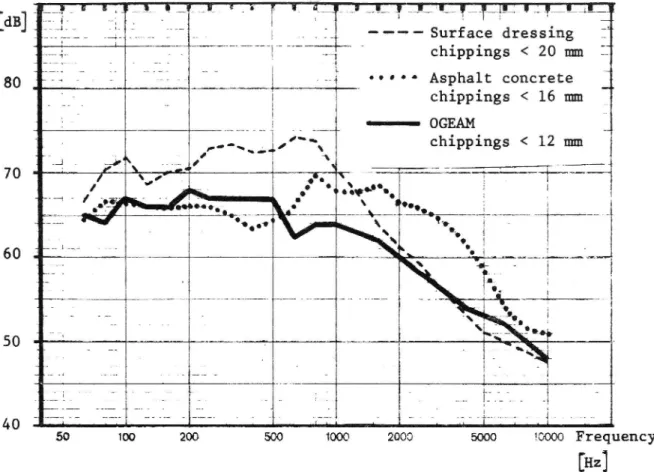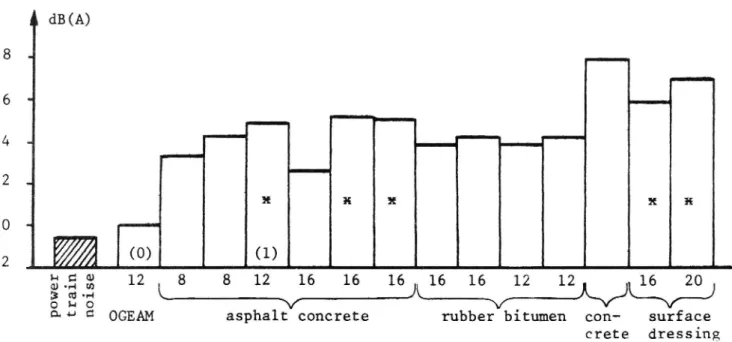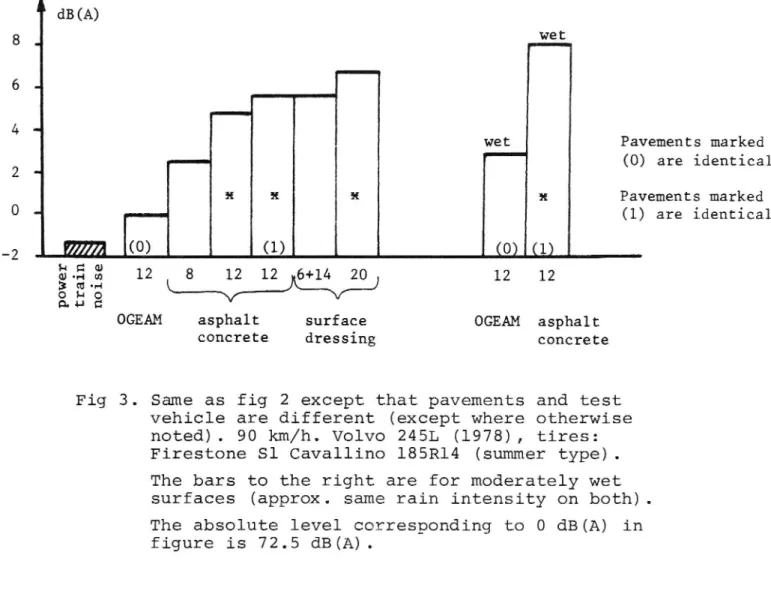No. 45 ' 1979
45
Statens väg- och trafikinstitut (VTI) - Fack - 581 01 Linköping National Road & Traffic Research Institute - Fack - 581 01 Linköping - Sweden
A Road Surface for Reduction
of Tire Noise Emission
by Ulf Sandberg, National Road & Traffic Research Institute
Reprint from the 1979 International Conference on Noise Control Engineering
(INTER-NOISE 79)
Proceedings
45
No. 45 - 1979
Statens väg- och trafikinstitut (VTI) - Fack - 581 01 Linköping National Road & Traffic Research Institute - Fack - 581 01 Linköping - Sweden
A Road Surface for Reduction
of Tire Noise Emission
by Ulf Sandberg, National Road & Traffic Research Institute
Reprint from the 1979 International Conference on Noise Control Engineering (INTER-NOISE 79)
Proceedings
Warszawa, Poland, 11 14 September 1979
CONTENTS
2229
INTRODUCTION l
PROBABLE GENERATING MECHANISMS FOR TIRE NOISE 2
EXPERIMENTAL PROGRAM 3
RESULTS 4
ACKNOWLEDGEMENT 6
REFERENCES 6
IHE INTERNATIONAL CONFERENCE ON NOSE CONTRG. ENGCNEERNG
o
A ROAD SURFACE FOR REDUCTION OF
"liet [love
TIRE NOISE EMISSION
by Ulf Sandberg M
National Swedish Road and Research Institute
8 581 01 Linköping, Sweden
wanszawa
roz.au:: .
INTRODUCTION
For most of the modern passenger cars tire noise is dominating the external noise emission for constant speeds above approximately 40-50 km/hX . This means that for freeflowing traffic a reduction of tire noise is necessary in order to achieve an improvement in
traffic noise.
Recent studies have pointed out that the type of road
surface can influence tire noise as much as, or more
than the type of tire. This indicates that a possible way to significantly reduce tire noise is to influence the choice of the road pavement.
Measurements in Great Britain and USA have shown that certain types of open graded asphalt pavements (i.e.
"porous" surfaces) reduce tire noise compared to
ordinary dense asphalt pavements. However this can not simply be transferred to Swedish conditions because of differences in climate and traffic, e.g. the frequent use of studded tires. Some open graded experimental
pavements have now been constructed in Sweden, of which
one was chosen for a noise test because of an expected favourable combination of air drainage prOperties and
x For very high speeds it is possible that aerodynamic noise might be important. For new cars in Sweden it has been shown that tire noise, represented by A
weighted values, sometimes will dominate even in the
relatively smooth surface. It is also predicted to give a significant sound absorption in the surface. To illustrate why these road characteristics are important a short review of possible generation mechanisms is given.
PROBABLE GENERATING MECHANISMS FOR TIRE NOISE
The mechanisms considered most probable at present can be summarized as follows (wet road noise generation
excluded).
o Tire radial Vibrations
Excited in radial direction by either tire tread elements impacting the road, or road roughness deforming the tire, radial vibrations or bending waves in the tire can emit noise. The existence of road texture (roughness) induced noise has recently been demonstrated in /l/.
o Tire tangential vibrations
Excited by stick slip or sliding motions in the
tire/road interface, vibrations in a tangential
direction might be produced.
o "Air pumping" in and out of the tire/road interface The compression and expansion of enclosed or partly
enclosed air between the road and the tire tread,
can be directly radiated as sound. The excitation might also be tire vibrations. This has recently been demonstrated by /2/.
Road texture induced noise will increase with roughness (texture) while "air pumping" noise will decrease with increased roughness, Therefore a porous but not too rough surface might be an optimum. If sound emission
also is attenuated by sound absorption in the surface, the net effect might be quite interesting.
EXPERIMENTAL PROGRAM
The studied porous pavement was a two year old open graded emulsified asphalt mix (OGEAM) with aggregate size up to 12 mm. This may be compared to a total of 13 other tested pavements (see fig 2 3).
The vehicles used for the tests are specified in fig 2
and 3. The tires were:
0 "Smooth tire". PIARC reference tire with a completely
smooth tread. Dimension 1658R15
0 "Summer tire". Firestone Sl Cavallino with a "summer
type" tread. Dimension 1658R15
0 "Winter tire". Firestone TC Asymmetric With a "winter type" tread. Dimension l6SSR15
0 "Summer tire". Firestone Sl Cavallino. Dimension l85Rl4 908
The latter was used during the measurement series pre
sented in fig 3, the others during the measurements
presented in fig 2. All tires were steel radials in a new condition. Measurements were made for both 70 and 90 km/h vehicle speeds.
The measurement method utilized was a Swedish method /3/ rather similar to SAEJ57a. Shortly, it requires measurements with fixed microphone 7,5 m from vehicle path and registration of both the maximum level (Lmax) and the energy equivalent level (Leq) during a vehicle passby. All measurements are corrected for non nominal
speeds and averaged for at least 5 vehicle passes. The 95% confidence interval with respect to random errors is as low as i 0,3 dB(A).
Besides the noise measurements an extensive road cha racterization was made. This included measurement of road texture (surface profile curves and fourier
analysis of these), drainage (water outflow time), skid resistance, sound absorption coefficient, sound pro pagation and mechanical impedance.
RESULTS
Some of the results are summarized in fig 1 3. As
comments or complements the following can be mentioned
(if not otherwise pointed out the results are valid for
a summer tire at 90 km/h on dry roadsz)
0 The open graded emulsified asphalt mix (OGEAM) gives approxa 5-6 dB(A) less tire noise than typical dense asphalt concrete pavements
o Although some extremely smooth surfaces (8 mm aggre gate size) for temporary use, appear less noisy than the other surfaces, they are still 2-3 dB(A) noisier than the OGEAM
o Pavement OGEAM gives 6 7 dB(A) less tire noise than the tested rough surface dressings now increasingly
used on Swedish roads
0 The results presented in fig 1 3 are not significant
ly changed when speed is 70 km/h instead of 90 km/h
0 The use of the "winter tire" gives essentially the
o For the smooth tire, some of the smoothest pavements
produce tire noise in the same range as the OGEAM.
0 A test on two moderately wet surfaces indicated that
the noise on OGEAM is 5 dB(A) lower than on a common
dense asphalt pavement.
o Even on the most "silent" road surface the tires are the dominating vehicle noise source at 70 90 km/h for the test vehicles. Tests with the engine switched on during the passbys revealed that power train noise, i.e. mainly engine-generated, was lower than tire
noise both at 70 and 90 km/h. This emphasizes the need for tire noise reduction.
o Among the other measured pavement characteristics can be mentioned that the texture height from the profile measurements (RMS of profile with DC component re
moved), were 0.3, 1.4 and 2.6 mm for the surfaces in
fig l (2.6 for surface dressing and l.4 for OGEAM).
0 In fig 1 can be seen that the OGEAM is more silent than the dense asphalt concrete pavement for frequen cies > 600 Hz. This is believed to be due to the elimination of "air pumping" noise, and possibly
some sound absorption. OGEAM is also more silent than the course surface dressing for frequencies < 2000 Hz. This is believed to be due to partly a less rough
surface, partly some sound absorption in the porous
surface. The differences in texture alone can not explain all of the difference in noise emission.
o Because of sound absorption characteristics it is probable that contributions also from other noise sources than the tires will be reduced by the porous road pavement.
ACKNOWLEDGEMENT
This work was sponsored by the National Swedish Board for Technical Development and the National Swedish Road and Traffic Research Institute. The main program was made in c00peration between this institute and IFM
Akustikbyrån AB.
REFERENCES
(l)
(2)
Sandberg, U. Road Texture Induced External Tire Noise Empirical Frequency Response Function
for Tires, Report No 174A, National Swedish
Road and Traffic Research Institute, Linköping (1979).
Nilsson, N.!X. Air resonant Radiation A Possible
Mechanism for High Frequency Noise from Cross
Bar Tires. TR 6.084.02 IFM Akustikbyrån AB,
Stockholm (1979).
Bennerhult, O. A Standard Method for Measurement
of Tire Noise, IFM Akustikbyrån AB, Stockholm
(1977).
Sandberg, U. Tire Noise as Part of Total Vehicle Noise Emission. International Tire Noise
Con-ference, Stockholm, 1979. National Swedish Board
70
60
50
40
173_="1L _! 3.3 1;?-T F =1i_ _J_I_?i1wl_!w%_iiliånlml_.. 1 _: 1 J » | __ lj;;_ _;f _ _ g _ii --- -Surface dressing f
_Zi%i _ """lw "*"TÄ"" chippings < 20 mm ? ÖT; " "* __ ' ! i """ Asphalt concrete jL ! chippings < 16 mm å __ "i _M_Å ___-_.ogmuq _ h ,...a ______3_,'""'x chippings < 12 m J! ? ___,-.. ___ |__ __ » l l _ ,-...._ _. ... __ A -l i . L A 500 2000 5000 !mxm Frequency
[Hz]
Fig 1. Tire noise on two common pavements compared to
pavement OGEAM. tires:
octave band spectra.
90 km/h. Volvo 142
SPL diff. + dB(A)
8 -
r...
, 6 u 4 4; 2 _ x x x x x 0 d r_2
W
<0)
(1)
, w 12 8 8 12 16 16 16 16 16 12 12 16 20ggg
L
Jt
ANAK_
)
Q 4 3 OGEAM asphalt concrete rubber bitumen con- surface crete dressing
Fig 2. Difference between tire noise on pavement OGEAM and other pavements. Dry roads. 90 km/h. Volvo
142 (1972), tires: Firestone Sl Cavallino 1655R15
(summer type).
Notes: The dashed bar is power train noise cal-culated from measurements of total vehicle noise and tire noise respectively. The numbers above the pavement specification,are the maximum aggregate size (mm). Pavements marked x are
typical on Swedish roads. Others are experimental,
Å dB(A)
wet q r-;_
l"
wet Pavements marked
T____, 'F (0) are identical x x x x Pavements marked - 1r-_- (1) are identical m (0) (1) (0) (l) ååå 12 & 8 12 12 6+14 20 12 12
8.33 8
V
OGEAM asphalt surface OGEAM asphalt
concrete dressing concrete
Fig 3. Same as fig 2 except that pavements and test vehicle are different (except where otherwise noted). 90 km/h. Volvo 245L (1978), tires: Firestone Sl Cavallino 185Rl4 (summer type). The bars to the right are for moderately wet surfaces (approx. same rain intensity on both). The absolute level corresponding to O dB(A) in figure is 72.5 dB(A).


